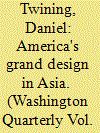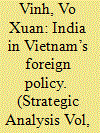| Srl | Item |
| 1 |
ID:
076848


|
|
|
|
|
| Publication |
2007.
|
| Summary/Abstract |
In a dynamic Asian order featuring new centers of power, China's rise will naturally challenge Washington's ability to protect its interests in the region. In 2000, presidential candidate George W. Bush labeled China as the United States' leading strategic and military competitor. In September 2005, Deputy Secretary of State Robert Zoellick explicitly warned Beijing not to "maneuver toward a predominance of power" in Asia, suggesting that it was doing exactly that.
In the face of this challenge, the United States has strengthened the two pillars of its Cold War-era regional security posture: its hub-and-spoke system of bilateral military alliances and its forward-deployed military forces. Washington has reconfigured its permanent troop deployments in Japan and South Korea, tightened its alliance with Australia, declared Thailand and the Philippines to be major non-NATO allies, and signed a wide-ranging strategic cooperation agreement with Singapore. Meanwhile, the Pentagon has deployed significant new power-projection capabilities to the region, including attack submarines, cruise-missile destroyers, long-range bombers, and fighter aircraft stationed in Guam.
To these two preexisting pillars of its Asian security strategy, the United States is adding a third, designed to hedge against the danger of Chinese hegemony in Asia by limiting and constructively channeling China's regional ambitions. U.S. policy seeks to accelerate the economic and military rise of key Asian states with the power potential and ambitions to constrain China's ability to dominate its region. The United States is not working to contain China. Rather, U.S. policymakers are employing a radically different strategy: to preserve Washington's strategic position in the region by facilitating the ascent of friendly Asian centers of power that will both constrain any Chinese bid for hegemony and allow the United States to retain its position as Asia's decisive strategic actor. In the face of the China challenge, the United States is encouraging the emergence of new centers of strength that will not erode U.S. power but protect the U.S. position in a new Asian balance featuring emerging world powers in China, Japan, and India.
|
|
|
|
|
|
|
|
|
|
|
|
|
|
|
|
| 2 |
ID:
170535


|
|
|
|
|
| Summary/Abstract |
The upgrading of Vietnam–India relations from partnership (2003) to strategic partnership (2007) and a comprehensive strategic partnership (2016) is not merely the result of India’s Look/Act East Policy. It also reflects Vietnam’s high appreciation of the Indian factor in its foreign policy since the Southeast Asian country promoted multilateralism and diversification in its international relations. The article analyses the importance of India in Vietnam’s foreign policy since its reform by examining its relations with India in fields of strategic politics, security, and defence which were guidelined in important political documents of Communist Party of Vietnam (CPV).
|
|
|
|
|
|
|
|
|
|
|
|
|
|
|
|